ICOM orporated 289300 VHF Transceiver User Manual Manual
ICOM Incorporated VHF Transceiver Manual
Manual

INSTRUCTION MANUAL
This device complies with Part 15 of the FCC Rules. Operation
is subject to the condition that this device does not cause
harmful interference.
iF3061T/S
VHF TRANSCEIVER
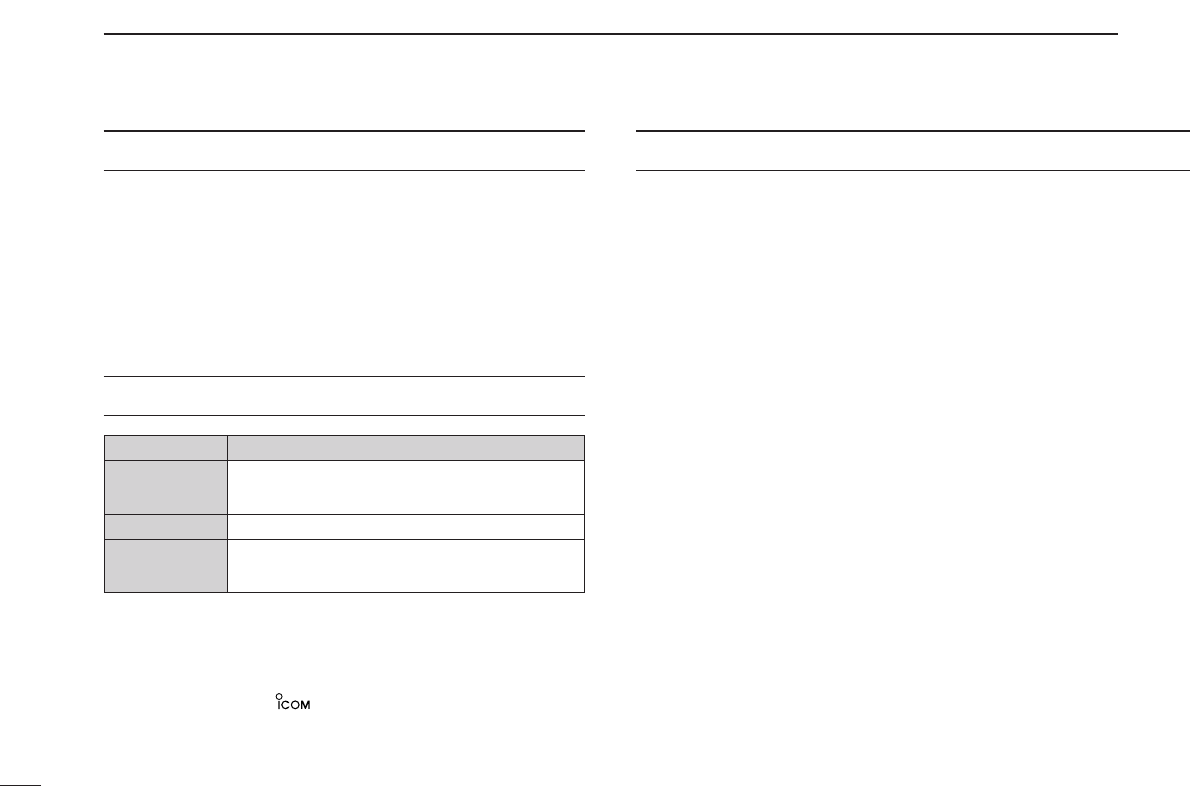
PRECAUTIONS
i
RCAUTION! NEVER hold the transceiver so that the
antenna is very close to, or touching exposed parts of the
body, especially the face or eyes, while transmitting. The
transceiver will perform best if the microphone is 2 to 4 in. (5
to 10 cm) away from the lips and the transceiver is vertical.
RCAUTION! NEVER operate the transceiver with a
headset or other audio accessories at high volume levels.
RCAUTION! NEVER short the terminals of the bat-
tery pack.
DO NOT push PTT when not actually desiring to transmit.
AVOID using or placing the transceiver in direct sunlight or
in areas with temperatures below +22°F (–30°C) or above
+140°F (+60°C).
The basic operations, transmission and reception of the trans-
ceiver are guaranteed within the specified operating temper-
ature range. However, the LCD display may not be operate
correctly, or show an indication in the case of long hours of
operation, or after being placed in extremely cold areas.
WORD DEFINITION
RWARNING Personal injury, fire hazard or electric shock
may occur.
CAUTION Equipment damage may occur.
NOTE If disregarded, inconvenience only. No risk
of personal injury, fire or electric shock.
READ ALL INSTRUCTIONS carefully and com-
pletely before using the transceiver.
SAVE THIS INSTRUCTION MANUAL— This
instruction manual contains important operating instructions
for the IC-F3061T/S VHF TRANSCEIVER.
IMPORTANT
Icom, Icom Inc. and the logo are registered trademarks of Icom
Incorporated (Japan) in the United states, the United Kingdom, Germany,
France, Spain, Russia and/or other countries.
SmarTrunk II™ and SmarTrunk 3G™ are Trademark of SmarTrunk Systems,
Inc.
EXPLICIT DEFINITIONS

ii
DO NOT modify the transceiver for any reason.
KEEP the transceiver from the heavy rain, and Never
immerse it in the water. The transceiver construction is water
resistant, not waterproof.
The use of non-Icom battery packs/chargers may impair
transceiver performance and invalidate the warranty.
For U.S.A. only
CAUTION: Changes or modifications to this transceiver, not
expressly approved by Icom Inc., could void your authority to
operate this transceiver under FCC regulations.

iii
IMPORTANT ........................................................................ i
EXPLICIT DEFINITIONS ..................................................... i
PRECAUTIONS ................................................................... i
TABLE OF CONTENTS ...................................................... iii
1ACCESSORIES ......................................................... 1–3
■Supplied accessories ................................................. 1
■Accessory attachments .............................................. 1
2PANEL DESCRIPTION ............................................. 4–9
■Front panel ................................................................. 4
■Function display ......................................................... 6
■Programmable function keys ..................................... 7
3BASIC OPERATION .............................................. 10–11
■Turning power ON .................................................... 10
■Channel selection .................................................... 10
■Call procedure........................................................... 11
4LTR OPERATION .................................................. 12–13
■Receiving a call ........................................................ 12
■Transmitting a call .................................................... 13
5CONVENTIONAL OPERATION ............................ 14–17
■Receiving and transmitting........................................ 14
■User Set mode.......................................................... 16
■Emergency transmission .......................................... 16
■Scrambler function.................................................... 16
■Stun function ............................................................ 17
■Priority A channel selection ...................................... 17
6BATTERY CHARGING .......................................... 18–21
■Battery charging ....................................................... 18
■Battery caution ......................................................... 18
■Optional battery chargers ......................................... 19
6SWIVEL BELT CLIP .............................................. 22–23
■MB-93 contents ........................................................ 22
■To attach .................................................................. 22
■To detach ................................................................. 23
6OPTIONS ............................................................... 24–25
7SAFETY TRAINING INFORMATION .................... 26–27
TABLE OF CONTENTS
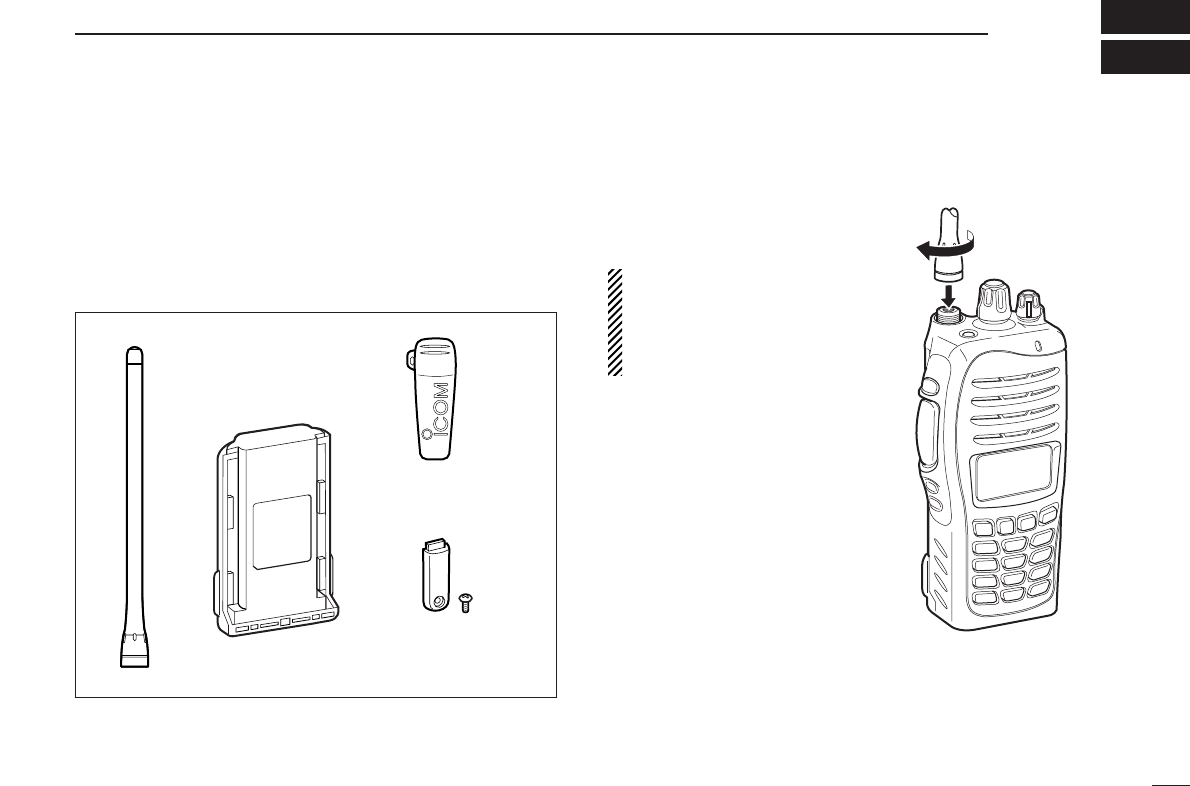
1
1
ACCESSORIES
■Supplied accessories
The following accessories are supplied: Qty.
qFlexible antenna ……………………………………………1
wBattery pack …………………………………………………1
eBelt clip ………………………………………………………1
rConnector cover (with screw) …………………………1 set
■Accessory attachments
DFlexible antenna
Connect the supplied flexible anten-
na to the antenna connector.
CAUTION!
• NEVER HOLD by the antenna
when carrying the transceiver.
• Transmitting without an antenna
may damage the transceiver.
qwe
r
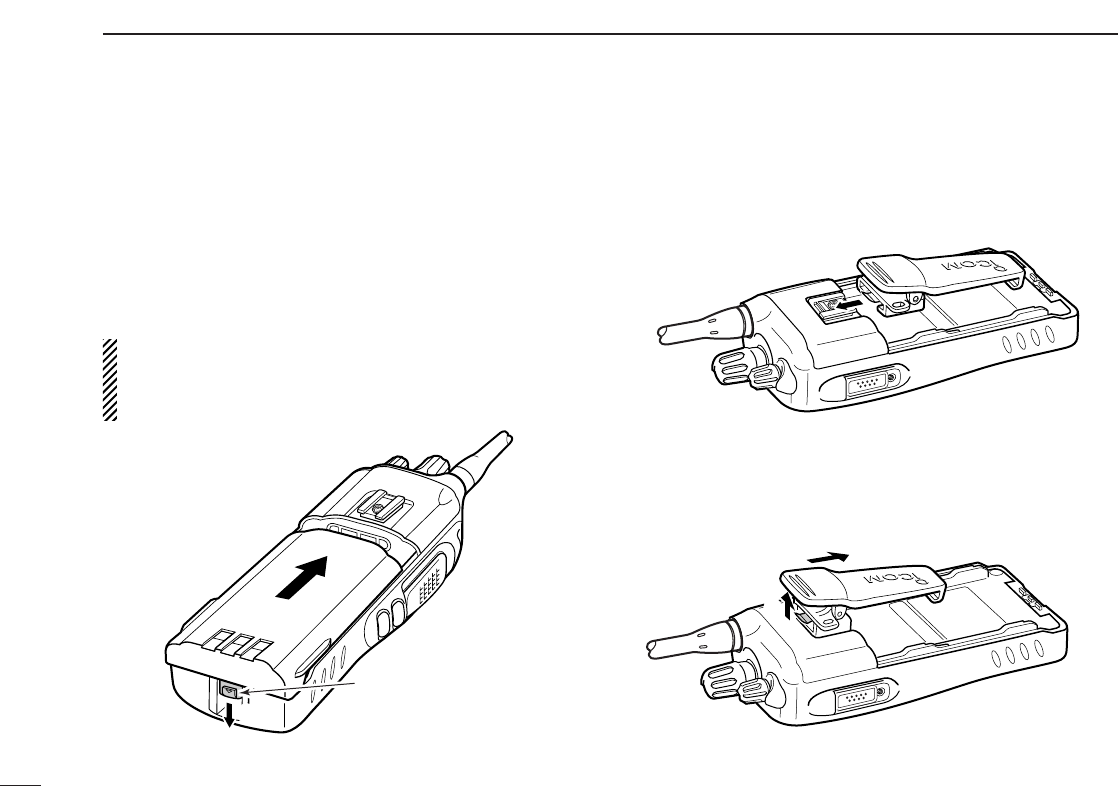
2
1ACCESSORIES
ïBattery pack
To attach the battery pack:
Slide the battery pack in the direction of the arrow (q), then
lock it with the battery release button.
• Slide the battery pack until the battery release button makes a ‘click’
sound.
To release the battery pack:
Slide the battery release button in the direction of the arrow
(w) as shown below. The battery pack is then released.
NEVER release or attach the battery pack when the trans-
ceiver is wet or soiled. This may result water or dust get-
ting into the transceiver/battery pack and may result in the
transceiver being damaged.
DBelt clip
To attach the belt clip:
qRelease the battery pack if it is attached.
wSlide the belt clip in the direction of the arrow until the belt
clip is locked and makes a ‘click’ sound.
To detach the belt clip:
qRelease the battery pack if it is attached.
wPinch the clip (q), and slide the belt clip in the direction of
the arrow (w).
q
w
q
w
Battery release button
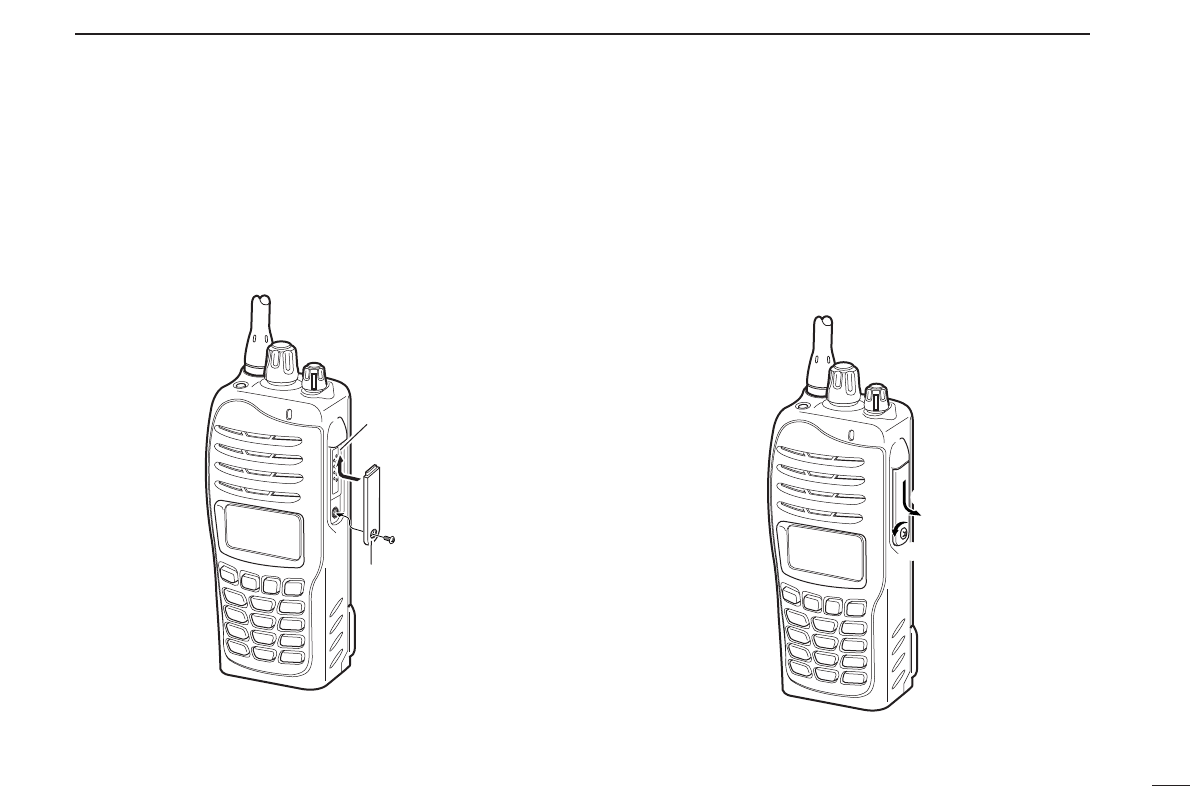
3
1
ACCESSORIES
ïJack cover
Attach the jack cover when the optional speaker-microphone
is not used.
To attach the connector cover:
qInsert the connector cover into the multi-conector.
wTighten the screw.
To detach the connector cover:
qUnscrew the screw using a phillips screwdriver.
wDetach the connector cover for the speaker-microphone
connector.
q
w
q
w
Multi-
connector
Connector
cover
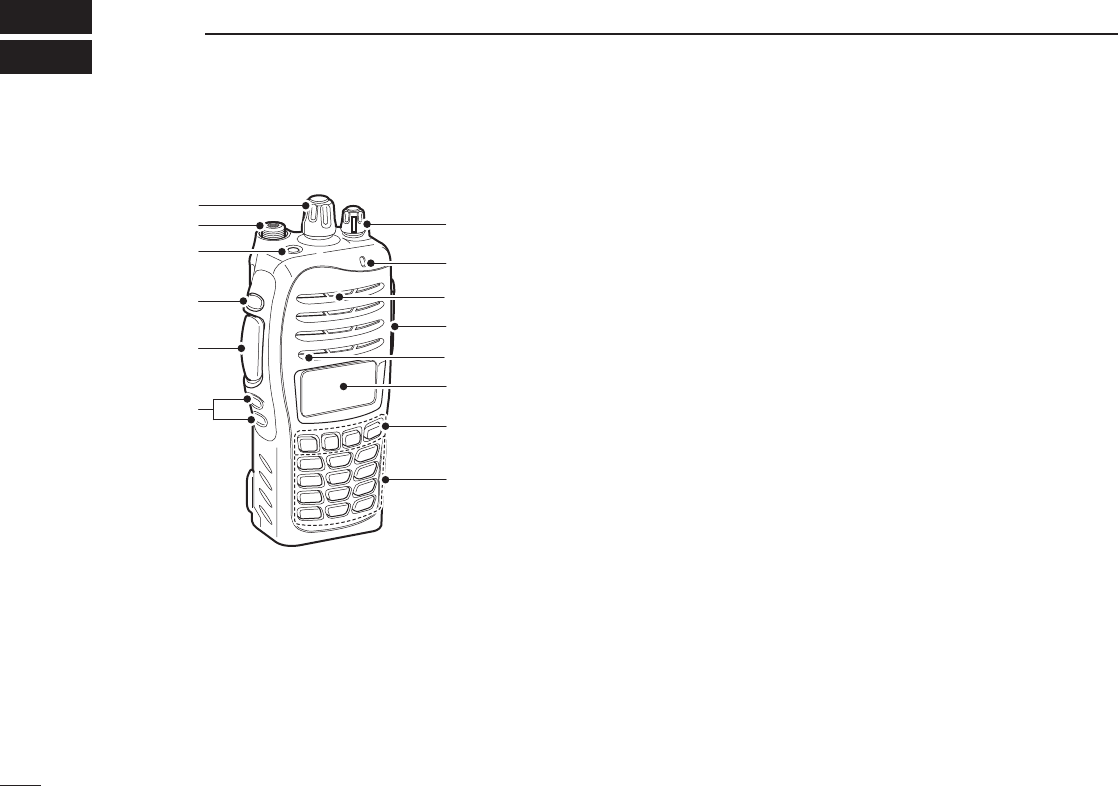
4
2PANEL DESCRIPTION
■Front panel
qROTARY SELECTOR
Rotate to select the pre-programmed memory channels or
the operating zone.
(Depending on the pre-setting)
wANTENNA CONNECTOR
Connects the supplied antenna.
eEMERGENCY SWITCH
Push and hold for a specified period to transmit an emer-
gency call.
*Desired function can be programmed by your dealer.
rMONITOR SWITCH
➥ Mute and release the CTCSS (DTCS) or 2-tone squelch
mute. Open any squelch/deactivate any mute while
pushing this key. (LMR operation only)
*Desired function can be programmed by your dealer.
tPTT SWITCH [PTT]
➥Push and hold to transmit; release to receive.
➥Push to transmit the call during MSK operation, depend-
ing on the setting.
yUP/DOWN KEYS
➥Push to select an operating channel.
➥Push to select a TX code channel after pushing
[TX CODE CH SELECT].
➥Push to select a DTMF channel after pushing [DTMF].
➥Push to select a scan group after pushing and holding
[SCAN].
*Desired functions can be programmed independently by your
dealer.
w
e
t
r
y
q
!1
!0
o
!2
u
i
Microphone
Speaker
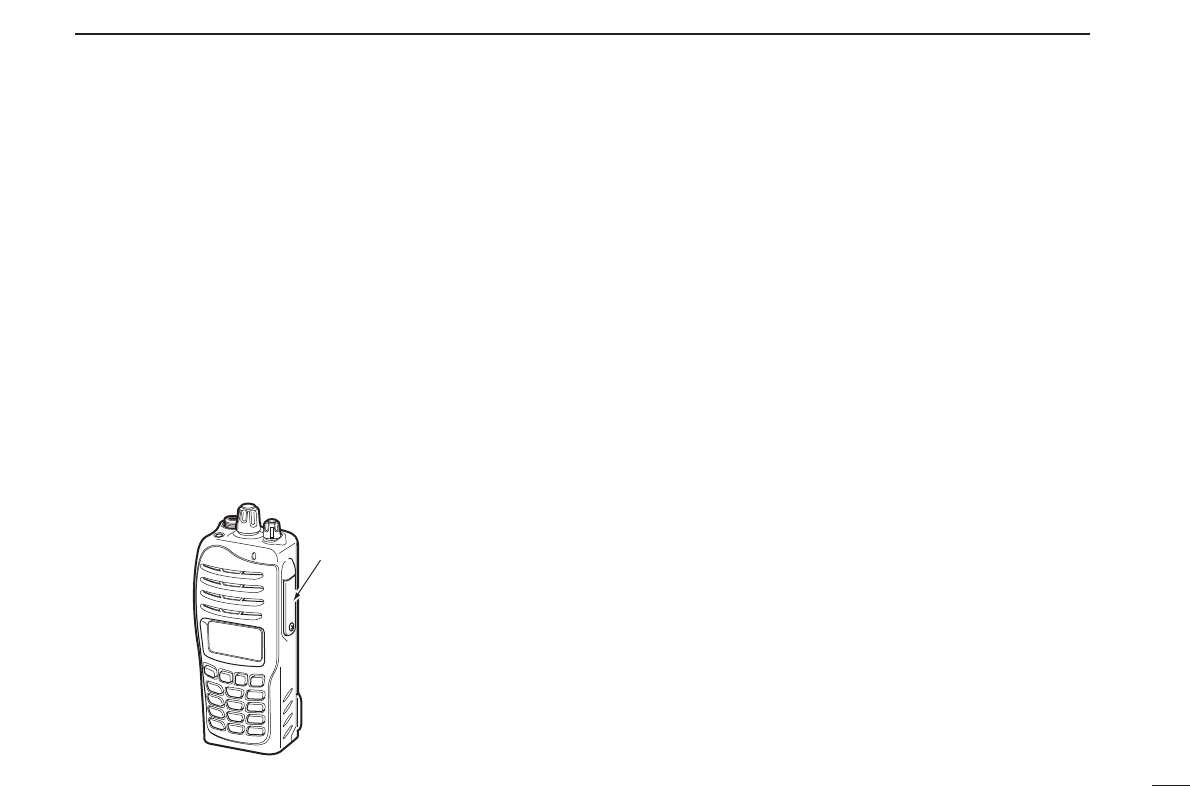
5
2
PANEL DESCRIPTION
u10-KEYPAD (Depending on version)
The keypad allows you to enter digits to:
• Select memory channels
• Select tone channels
• Select DTMF codes (during transmit)
• Set TX codes
• Start up with the password
iDEALER-PROGRAMMABLE KEYS [P0] to [P3]
Desired functions can be programmed independently by
your dealer.
oFUNCTION DISPLAY
Displays a variety of information such as an operating
channel number/name, 2/5-tone code, DTMF numbers,
selected function, etc.
!0 MULTI-CONNECTOR
Connect an optional speaker-microphone.
!1 BUSY/TRANSMIT INDICATOR
➥ Lights green while receiving a signal, or when the
squelch is open.
➥ Lights red while transmitting.
!2 VOLUME CONTROL [VOL]
Rotate to turn the power ON/OFF and adjusts the audio
level.
Connector cover
NOTE: Attach the connec-
tor cover when the optional
speaker-microphone is not
used. (See p. 3 for details)
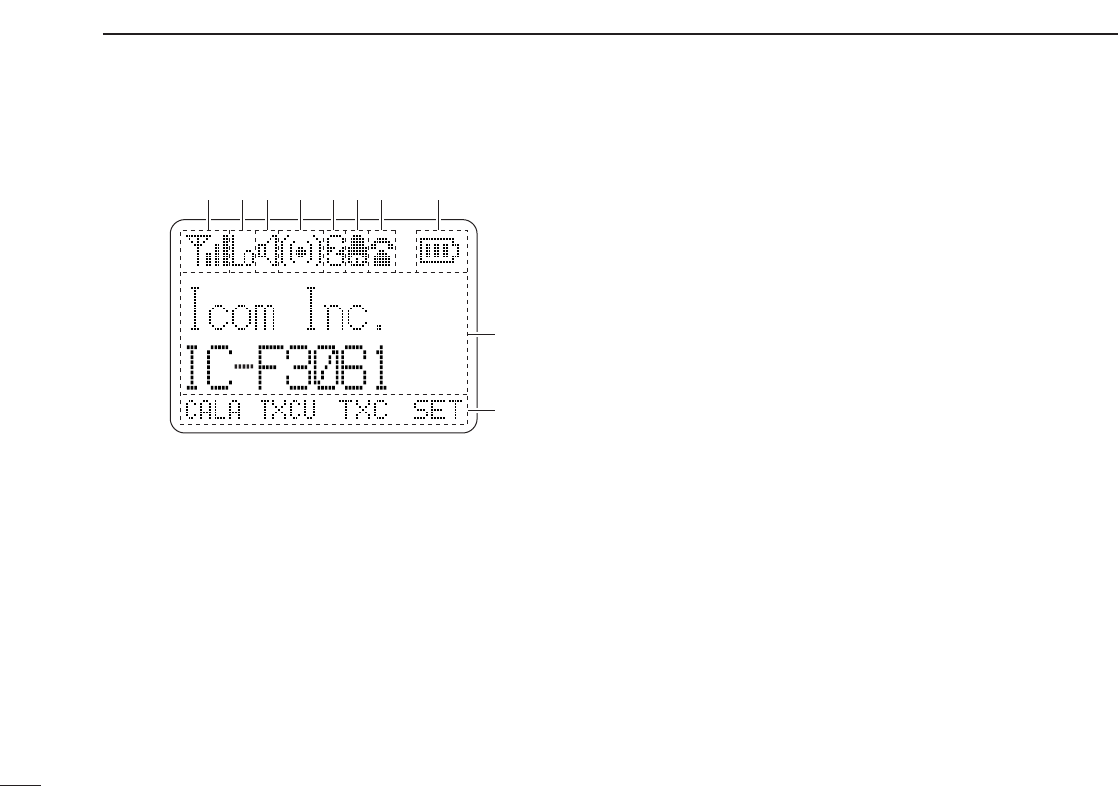
6
2PANEL DESCRIPTION
■Function display
qSIGNAL STRENGTH INDICATOR
Indicates relative signal strength level.
wLOW POWER INDICATOR
Appears when low output power is selected.
eAUDIBLE INDICATOR
➥Appears when the channel is in the ‘audible’ (unmute)
condition.
➥Appears when the specified 2/5-tone is received.
rCOMPANDER INDICATOR
Appears when the compander function is activated.
tSCRAMBLER INDICATOR
Appears when the voice scrambler function is activated.
yBELL INDICATOR
➥Appears/blinks when the specific 2/5-tone/DTMFselect
call is received, according to the pre-programming.
uCALL CODE MEMORY INDICATOR
Appears when the call code memory is selected.
iBATTERY INDICATOR
Appears or blinks when the battery power decreases to a
specified level.
oALPHANUMERIC DISPLAY
➥Displays an operating channel number, channel name,
Set mode contents, DTMF code, etc.
➥The indication mode can be selected from 1 line or 2
lines. Ask your dealer for details.
• In this instruction manual, the LCD illustration is described
using the 2 lines indication mode.
!0 KEY INDICATOR
Indicate the programmed function of the front panel keys
([P0], [P1], [P2] and [P3]).
q t iuyrew
o
!0

7
2
PANEL DESCRIPTION
■Programmable function keys
The following functions can be assigned to [EMERGENCY],
[MONITOR], [UP], [DOWN], [P0], [P1], [P2] and [P3] pro-
grammable function keys.
Consult your Icom dealer or system operator for details con-
cerning your transceivers programming.
If the programmable function names are bracketed in the fol-
lowing explanations, the specific key is used to activate the
function depends on the programming.
CH UP AND DOWN KEYS
➥Push to select an operating channel.
➥Push to select a transmit code channel after pushing [TX
Code CH Select].
➥Push to select a DTMF channel after pushing [DTMF
Autodial].
➥Push to select a scan group after pushing and holding
[Scan A Start/Stop]/[Scan B Start/Stop].
ZONE KEY
Push this key, then push [CH Up] or [CH Down] to select the
desired zone.
What is “zone”?— The desired channels are assigned
into a zone according to the intended use for grouping. For
example, ‘Staff A’ and ‘Staff B’ are assigned into a
“Business” zone, and ‘John’ and ‘Cindy’ are assigned into a
“Private” zone.
SCAN A KEY
➥This key’s operation depends on the Power ON Scan set-
ting.
When the power ON scan function is turned OFF;
Push to start and cancel scanning operation. In case of
transmission during scan, cancels scanning.
When the power ON scan function is turned ON;
Push to pause scanning. Scanning resumes after passing
a specified time period. In case of transmission during
scan, pauses scanning. Scanning resumes after passing
a specified time period specified.
➥Push and hold this key for 1 sec. to indicate the scan
group, then push [CH Up] or [CH Down] to select the
desired group.
SCAN B KEY
➥Push to start and cancel scanning operation. In case of
transmission during scan, pauses scanning. Scanning
resumes after passing a specified time period.
➥Push and hold this key for 1 sec. to indicate the scan
group, then push [CH Up] or [CH Down] to select the
desired group.

8
2PANEL DESCRIPTION
SCAN ADD/DEL (TAG) KEY
Push to add or delete the selected channel to/from the scan
group.
PRIO A/B KEYS
➥Push to select Priority A or Priority B channel.
➥Push and hold [Prio A (Rewrite)] to rewrite the Prio A chan-
nel.
MR-CH 1/2/3/4 KEYS
Push to select an operating channel directly.
MONI KEY
Mute and release the CTCSS (DTCS) or 2-tone squelch
mute. Open any squelch/deactivate any mute while pushing
this key.
LIGHT KEY
Push to turn the transceiver’s backlight ON temporarily only
when the backlight function is turned OFF in user set mode.
LOCK KEY
➥Push and hold for 1 sec. to electronically lock all program-
mable keys except the following:
[Call] (incl. Call A and Call B), [Moni(Audi)] and
[Emergency].
➥Push and hold for 1 sec. again to turn the lock function
OFF.
HIGH/LOW KEY
Push to select the transmit output power temporarily or per-
manently, depending on the pre-setting.
•Ask your dealer for the output power level for each selection.
C.TONE CH ENT KEY
Push to select the continuous tone channel using
[CH Up]/[CH Down] to change the tone frequency/code set-
ting. The selected channel remains set as the continuous
tone channel until another channel is designated as such.
TALK AROUND KEY
Push to turn the talk around function ON and OFF.
•The talk around function equalizes the transmit frequency to the
receive frequency for transceiver-to-transceiver communication.
WIDE/NARROW KEY
Push to toggle the IF bandwidth between wide and narrow.
DTMF AUTODIAL KEY
➥Push to enter the DTMF channel selection mode. Then
select the desired DTMF channel using [CH Up]/[CH
Down].
➥After selecting the desired DTMF channel, push this key to
transmit the DTMF code.
RE-DIAL KEY
Push to transmit the last-transmitted DTMF code.

9
2
PANEL DESCRIPTION
CALL KEYS
Push to transmit a 2/5-tone/BIIS ID code.
•Call transmission is necessary before you call another station
depending on your signalling system.
•[Call A] and/or [Call B] may be available when your system employs
selective ‘Individual/Group’ calls. Ask your dealer which call is
assigned to each key.
EMERGENCY KEY
Push and hold for a specified period to transmit an emer-
gency call.
• If you want to cancel the emergency call, push (or push and hold)
the key again before transmitting the call.
• The emergency call is transmitted one time only or repeatedly until
receiving a control code depending on the pre-setting.
SURVEILLANCE KEY
Push to turn the surveillance function ON or OFF.
When this function is turned ON, the beep is not emitted and
the LCD backlight does not light when a signal is received or
a key is pushed, etc.
TX CODE CHANNEL SELECT KEY
➥Push to enter the ID code channel selection mode directly.
Then set the desired channel using [CH Up]/[CH Down]. (p.
13)
TX CODE CHANNEL UP/DOWN KEYS
Push to select a TX code channel directly.
SCRAMBLER FUNCTION
Push to toggle the voice scrambler function ON and OFF.
COMPANDER KEY
Push to toggle the compander function ON and OFF.
The compander function reduces noise components from the
transmitting audio to provide clear communication.
USER SET MODE KEY
➥Push and hold to enter user set mode.
• During user set mode, push this key to select an item, and
change the value or condition using push [CH Up]/[CH Down].
➥Push and hold this key again to exit user set mode.
User set mode is also available via the ‘Power ON function.’
Refer to p. 16 also.
OPT OUT KEYS
Push to control the output signal level of the optional ports in
the optional unit connector.
OPT MOMENTARY KEYS
Push and hold to control the output signal level of the option-
al ports in the optional unit connector.
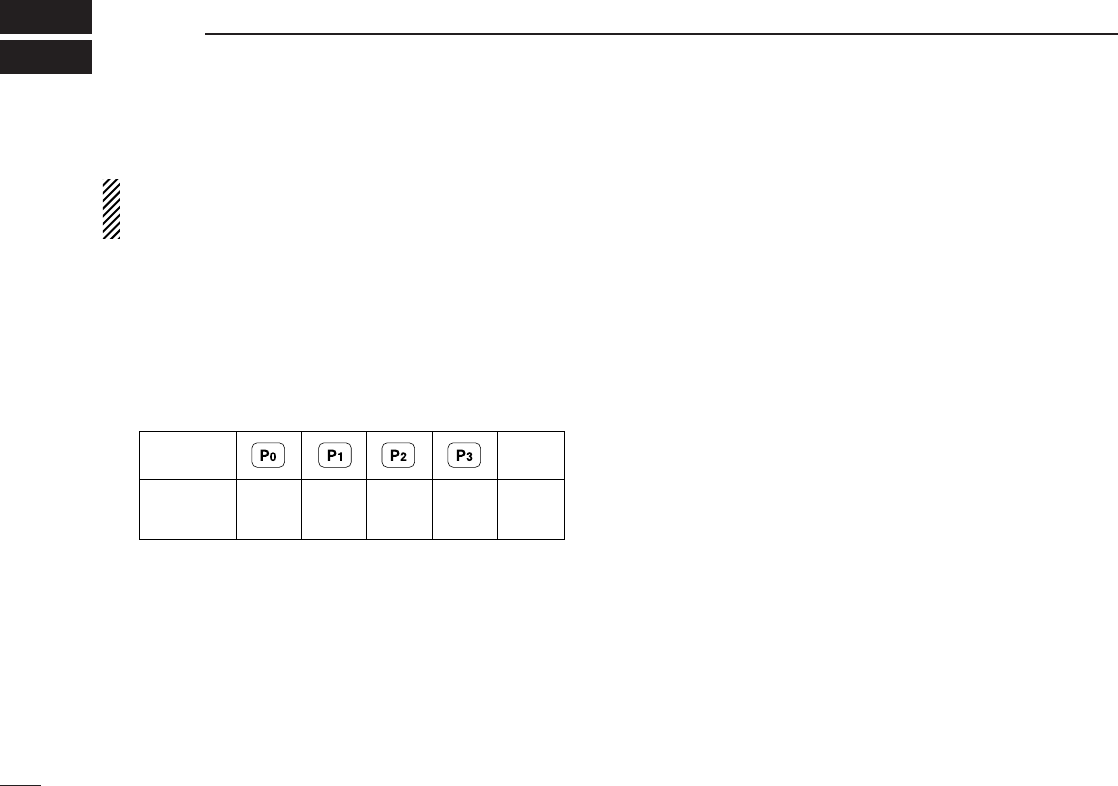
■Turning power ON
Prior to using the transceiver for the first time, the battery
pack must be fully charged for optimum life and operation.
(p. 18)
qRotate [VOL] to turn the power ON.
wIf the transceiver is programmed for a start up password,
input the digit codes as directed by your dealer.
• 10-keypad can be used for password input depending on ver-
sion:
• The keys in the table below can be used for password input:
• The transceiver detects numbers in the same block as identical.
Therefore “01234” and “56789” are the same.
eWhen the “PASSWORD” indication does not clear after
inputting 4 digits, the input code number may be incorrect.
Turn the power off and start over in this case.
■Channel selection
Several types of channel selections are available. Methods
may differ according to your system set up.
NON-ZONE TYPE:
Push [CH Up] or [CH Down], or rotate [ROTARY SELEC-
TOR]* to select the desired operating channel, in sequence;
or, push one of [MR-CH 1] to [MR-CH 4] keys to select a
channel directly.
• Up to 16 pre-programmed channels can be selected via [ROTARY
SELECTOR].*
ZONE TYPE:
Push [Zone], then push [CH Up] or [CH Down] or rotate
[ROTARY SELECTOR]* to select the desired zone.
AUTOMATIC SCAN TYPE:
Channel setting is not necessary for this type. When turning
power ON, the transceiver automatically starts scanning.
Scanning stops when receiving a call.
*Depending on the pre-setting.
KEY
NUMBER 0
5
4
9
3
8
2
7
1
6
DOWN
10
3BASIC OPERATION
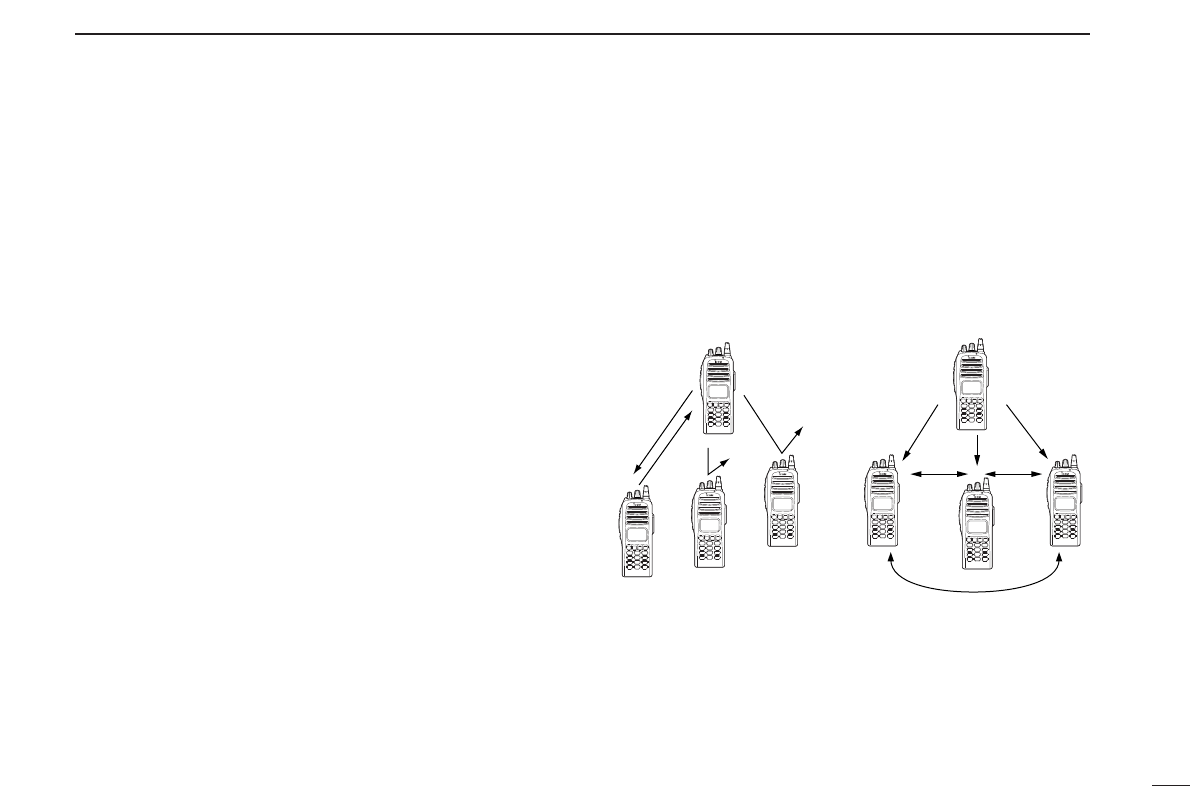
11
3
BASIC OPERATION
■Call procedure
When your system employs tone signaling (excluding CTCSS
and DTCS), the call procedure may be necessary prior to voice
transmission. The tone signalling employed may be a selec-
tive calling system which allows you to call specific station(s)
only and prevent unwanted stations from contacting you.
qSelect the desired TX code channel or 2/5-tone code
according to your System Operator’s instructions.
• This may not be necessary depending on programming.
wPush the call key (assigned to one of the dealer program-
mable keys: [Up], [Down], [P0], [P1], [P2], [P3],
[Emergency] and [Monitor]) or [PTT].
eAfter transmitting a 2/5-tone code, the remainder of your
communication can be carried out in the normal fashion.
Selective calling Non-selective calling
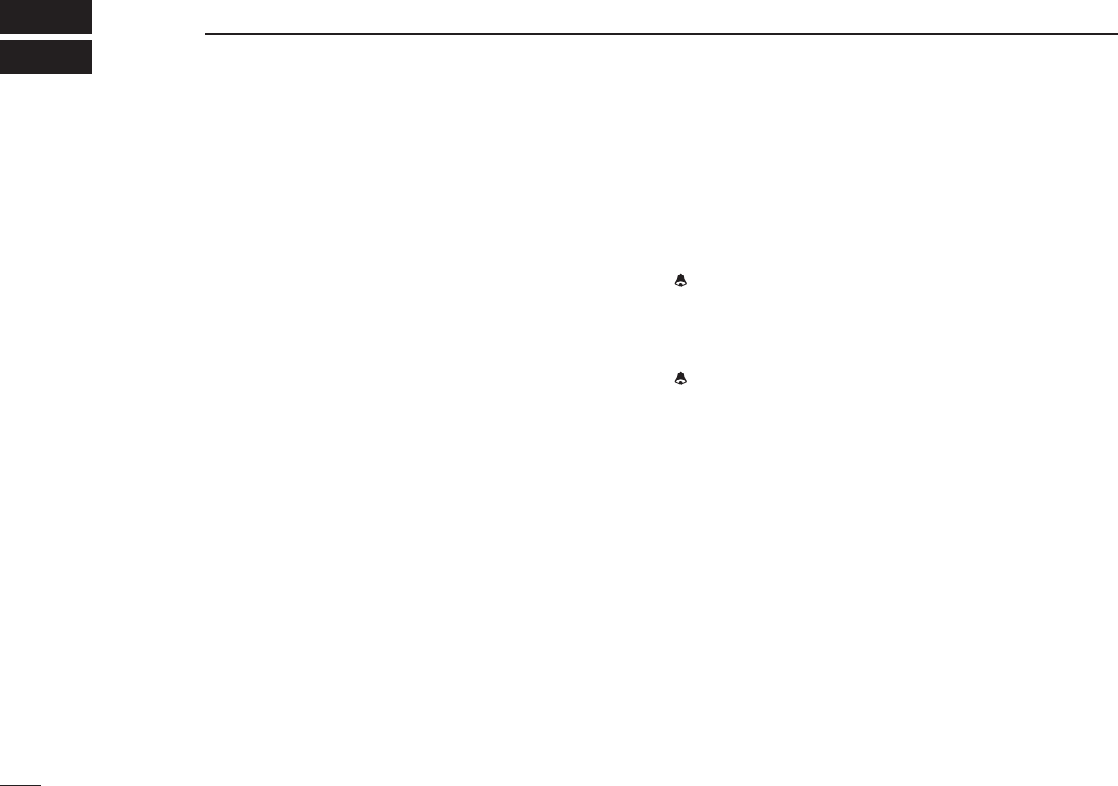
■Receiving a call
DGroup call
qPush [CH Up] or [CH Down], or rotate [ROTARY SELEC-
TOR]to select the LTR system channel or talk group.
wWhen a call is received;
•‘BUSY’ indicator lights green, and the calling station name/ID
appears.
ePush and hold [PTT], then speak into the microphone at
a normal voice level.
rRelease [PTT] to return to receive.
DSelective call (DTMF call)
qPush [CH Up] or [CH Down], or rotate [ROTARY SELEC-
TOR]to select the LTR system channel or talk group.
wPush [Call] to mute the channel.
•“”appears.
eWhen receiving a call, the calling station name appears
and a beep is emitted. Then the mute is released.
•“”disappears.
12
4LTR OPERATION

13
4
LTR OPERATION
DPhone call
qPush [CH Up] or [CH Down], or rotate [ROTARY SELEC-
TOR]to select the LTR system channel or talk group.
wWhen a phone call is received (transceiver rings), push
and hold [PTT], then speak into the microphone at a nor-
mal voice level.
•“”blinks and calling station name/ID appears for 1 sec.
eRelease [PTT] to return to receive.
rPush [#] while pushing [PTT] to finish the communication.
■Transmitting a call
DGroup call
qPush [CH Up] or [CH Down], or rotate [ROTARY SELEC-
TOR]to select the LTR system channel or talk group.
wWhile pushing and holding [PTT], speak into the micro-
phone at a normal voice level after a beep is emitted.
• If an error beep is emitted, release [PTT]. After a while, repeat
step w.
• The beep can be turned OFF in User set mode.
DSelective call (DTMF call)
qPush [CH Up] or [CH Down], or rotate [ROTARY SELEC-
TOR]to select the LTR system channel or talk group.
wPush [DTMF Autodial]— a DTMF encode channel
appears.
ePush [CH Up] or [CH Down] to select the desired DTMF
encode channel.
rPush [PTT] to transmit the selected DTMF code in the
selected DTMF channel.
• Push [DTMF Autodial] to cancel the DTMF transmission.
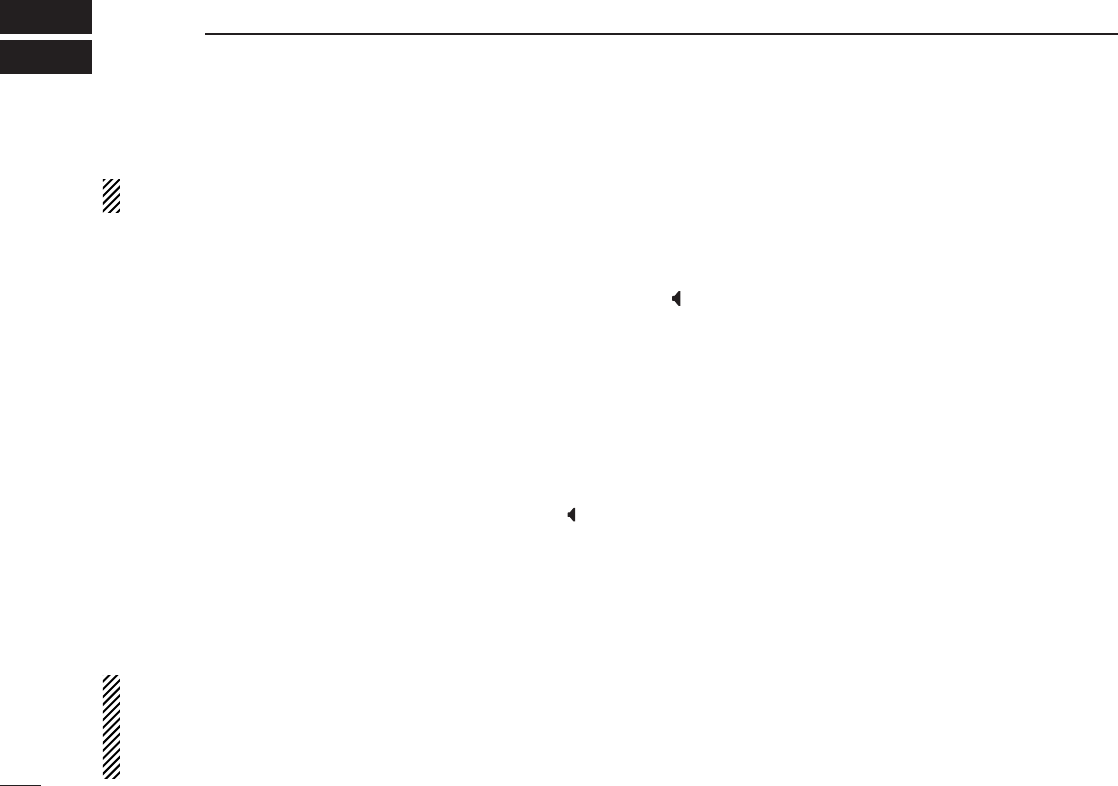
14
5CONVENTIONAL OPERATION
■Receiving and transmitting
NOTE: Transmitting without an antenna may damage the
transceiver. See p. 1 for antenna attachment.
Receiving:
qRotate [VOL] to turn the power ON.
wPush [CH Up] or [CH Down], or rotate [ROTARY SELEC-
TOR]* to select the conventional system channel, in
sequence.
*Depending on the pre-setting.
eWhen receiving a call, adjust the audio output level to a
comfortable listening level.
Transmitting:
Wait for the channel to become clear to avoid interference.
qPush [Call] when initiating a call from your side.
• Coded audio may be heard from the transceiver, then “”
appears.
• This operation may not be necessary depending on your signal-
ing system. Ask your dealer for details.
wWhile pushing and holding [PTT], speak into the micro-
phone at a normal voice level.
eRelease [PTT] to return to receive.
IMPORTANT: To maximize the readability of your signal;
1. Pause briefly after pushing [PTT].
2. Hold the microphone 5 to 10 cm (2 to 4 inches) from
your mouth, then speak into the microphone at a nor-
mal voice level.
DTransmitting notes
• Transmit inhibit function
The transceiver has several inhibit functions which restrict
transmission under the following conditions:
- The channel is in mute condition (‘Inaudible’ condition;
“” does not appear.)
- The channel is busy.
- Un-matched (or matched) CTCSS is received.
(Depending on the pre-setting.)
- The selected channel is a ‘receive only’ channel.
• Time-out timer
After continuous transmission for the pre-programmed time
period, the time-out timer is activated, causing the transceiv-
er to stop transmitting.
• Penalty timer
Once the time-out timer is activated, transmission is further
inhibited for a period determined by the penalty timer.

15
5
CONVENTIONAL OPERATION
DTX code channel selection
If the transceiver has [TX Code CH Select] assigned to it, the
indication can be toggled between the operating channel
number (or name) and TX code channel number (or name).
When the TX code channel number (or name) is displayed,
[CH Up] or [CH Down] selects the TX code channel.
USING [TX CODE CH SELECT] KEY:
qPush [TX Code CH Select]— a TX code channel number
(or name) appears.
wPush [CH Up] or [CH Down] to select the desired TX code
channel.
ePush [Call] (or [PTT] during MSK operation) to transmit the
selected TX code.
rPush [TX Code CH Select] again to return to the operat-
ing channel number indication.
USING [TX CODE CH UP]/[TX CODE CH DOWN] KEY:
If the transceiver has a [TX Code CH Up] or [TX Code CH
Down] key assignment, the programmed TX code channel
can be selected directly when pushed.
DDTMF transmission
If the transceiver has [DTMF Autodial] assigned to it, the auto-
matic DTMF transmission function is available. Up to 8 DTMF
channels are available.
TO SELECT A TX CODE:
qPush [DTMF Autodial]— a DTMF channel appears.
wPush [CH Up] or [CH Down] to select the desired DTMF
channel.
ePush [DTMF Autodial] to transmit the DTMF code in the
selected DTMF channel.

16
5CONVENTIONAL OPERATION
■User set mode
User set mode is accessed at power ON and allows you to
set seldom-changed settings. In this case you can “cus-
tomize” the transceiver operation to suit your preferences and
operating style.
Entering the user set mode:
qWhile pushing and holding [P1] and [P2], rotate [VOL] to
turn the power ON. Then, push and hold [P0] to enter user
set mode.
wPush [P0] several times to select the appropriate item.
Then push [Up] or [Down] to set the desired level/condi-
tion.
• Available set mode functions are Backlight, LCD contrast,
Beep, Beep Level, Ringer Level, SQL Level, AF Min Level,
Mic Gain, VOX Gain, VOX Delay, Battery Voltage and Signal
Moni.
eRotate [VOL] to turn the power OFF to exit user set mode.
NOTE: User set mode is also available via a programma-
ble key. Please refer to p. 9 [User Set Mode] section.
■Emergency transmission
When [Emergency Single] or [Emergency Repeat] is pushed,
an emergency signal is automatically transmitted for the spec-
ified time period.
When [Emergency] is pushed, the DTMF emergency signal
is transmitted on the priority channel.
When [Emergency Single] or [Emergency Repeat] is pushed
for the specified time period, the DTMF emergency signal is
transmitted once or repeatedly on the emergency channel.
However, when no emergency channel is specified, the signal
is transmitted on the previously selected channel.
■Scrambler function
The voice scrambler function provides private communication
between stations. The frequency inversion type is equipped
to all versions, moreover, the optional Rolling or Non-rolling
type can be available.
qPush [Scrambler] to turn the scrambler function ON.
• “ ” appears.
wPush [Scrambler] again to turn the scrambler function
OFF.
• “ ” disappears.

17
5
CONVENTIONAL OPERATION
■Stun function
When the specified ID, set as a killer ID, is received, the stun
function is activated.
When the killer ID is received, the transceiver switches to the
password required condition. Entering of the password via the
keypad is necessary to operate the transceiver again in this
case.
■Priority A channel selection
When one of the following operations is performed, the trans-
ceiver selects the Priority A channel automatically.
Priority A is selected when;
•Clear down signal is received/transmitted
-Set the ‘Move to PrioA CH’ item as ‘Clear down.’
•Turning the power ON
The Priority A channel is selected each time the trans-
ceiver power is turned ON.
•Status call
The Priority A channel is selected when transmitting a sta-
tus call.
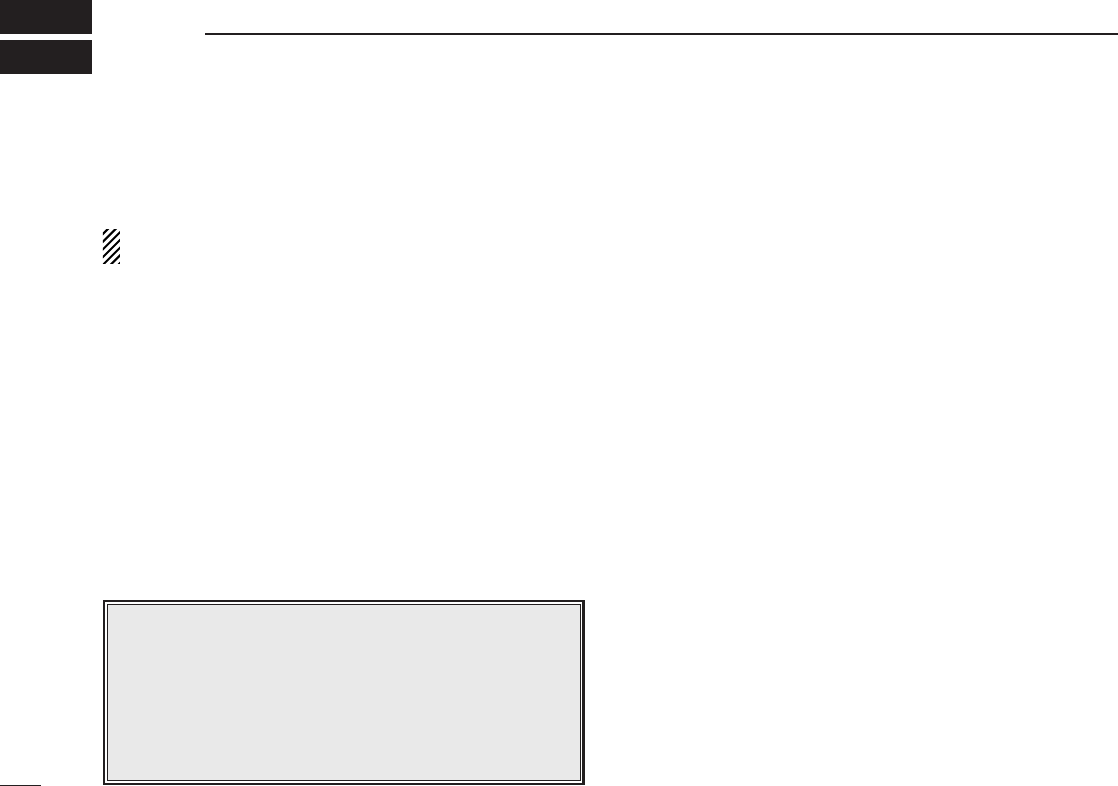
18
6BATTERY CHARGING
■Battery charging
Prior to using the transceiver for the first time, the battery
pack must be fully charged for optimum life and operation.
CAUTION: To avoid damage to the transceiver, turn the
power OFF while charging.
• Recommended temperature range for charging:
+10°C to +40°C (+50°F to +104°F)
• Use the specified chargers (BC-119N, BC-121N and BC-
160). NEVER use another manufacture’s charger.
• Use the specified AC adapter. NEVER use another manu-
facture’s adapter.
■Battery caution
RDANGER Charge the specified Icom batteries only.
Only tested and approved for use with genuine Icom batter-
ies. Fire and/or explosion may occur when a third party bat-
tery pack or counterfeit product is charged.
CAUTION! NEVER insert battery pack/transceiver (with the
battery pack attached) in a wet or soiled condition into the
charger. This may result in corrosion of the charger terminals
or damage to the charger. The charger is not waterproof and
water can easily get into it.
NEVER incinerate used battery packs. Internal battery gas
may cause an explosion.
NEVER immerse the battery pack in water. If the battery
pack becomes wet, be sure to wipe it dry BEFORE attaching
it to the transceiver.
NEVER short the terminals of the battery pack. Also, current
may flow into nearby metal objects, such as a necklace, etc.
Therefore, be careful when carrying with, or placing near
metal objects, carrying in handbags, etc.
AVOID leaving the battery pack in a fully charged, or completely
discharged condition for long time. It causes shorter battery life.
In case of leaving the battery pack unused for a long time, it
must be kept safely after discharge, or use the battery until the
battery indicator appears, then remove it from the transceiver.
If your battery pack seems to have no capacity even after
being charged, fully charge the battery pack again. If the bat-
teries still do not retain a charge (or very little), new battery
pack must be purchased.
Recommendation:
Charge the supplied battery pack for a maximum of
up to 10 hours. Li-Ion batteries are different from Ni-
Cd batteries in that it is not necessary to completely
charge and discharge them to prolong the battery life.
Therefore, charging the battery in intervals, and not
for extended periods is recommended.
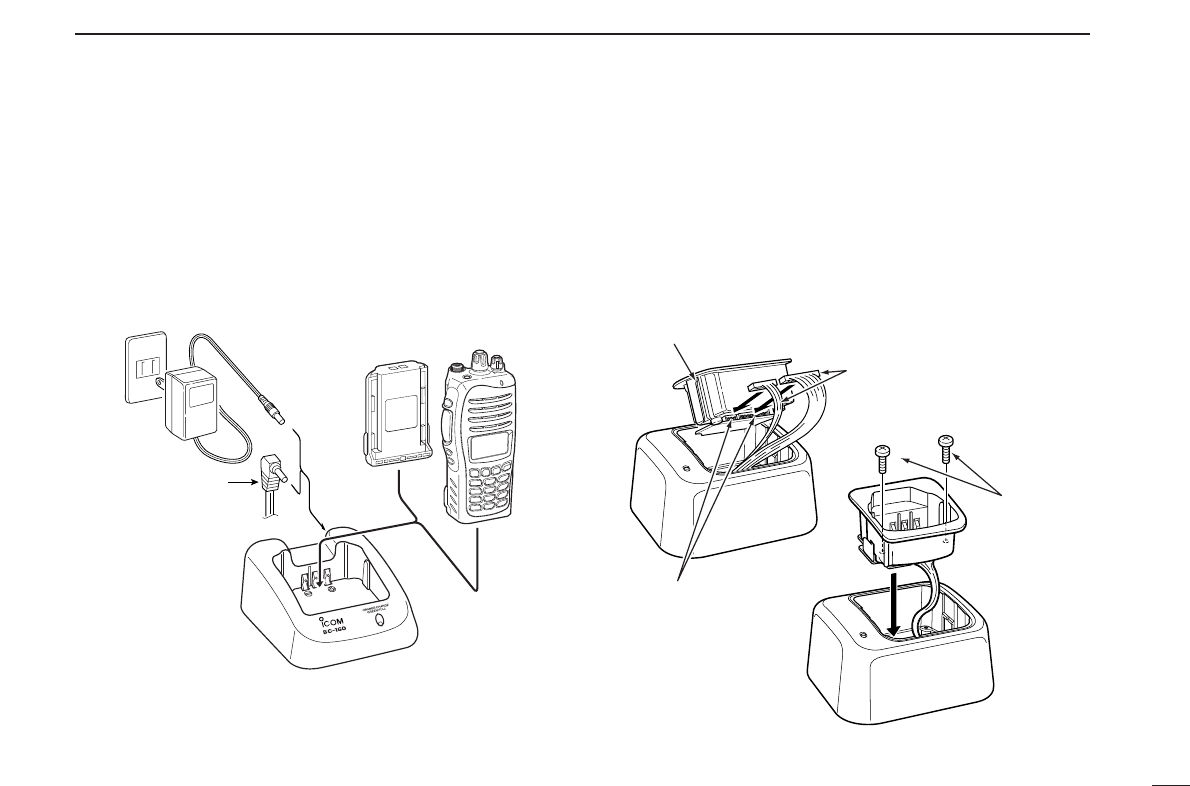
19
6
BATTERY CHARGING
■Optional battery chargers
ïRapid charging with the BC-160
The optional BC-160 provides rapid charging of optional Li-
Ion battery packs.
• An AC adapter (may be supplied with BC-160 depending on
version) or the DC power cable (OPC-515L/CP-17L) is addi-
tionally required.
ïAD-106 installation
qInstall the AD-106 desktop charger adapter into the holder
space of the BC-119N/BC-121N.
wConnect the plugs of the BC-119N/BC-121N to the AD-106
desktop charger adapter with the connector, then install
the adapter into the charger with the supplied screws.
Screws supplied
with the charger
adapter
AD-106
Connectors
Plugs
q
w
AC adapter
(Not supplied with
some versions.)
Optional OPC-515L
(for 13.8 V power
source) or CP-17L
(for 12 V cigarette
lighter socket) can
be used instead of
the AC adapter.
IC-F3061
BP-232
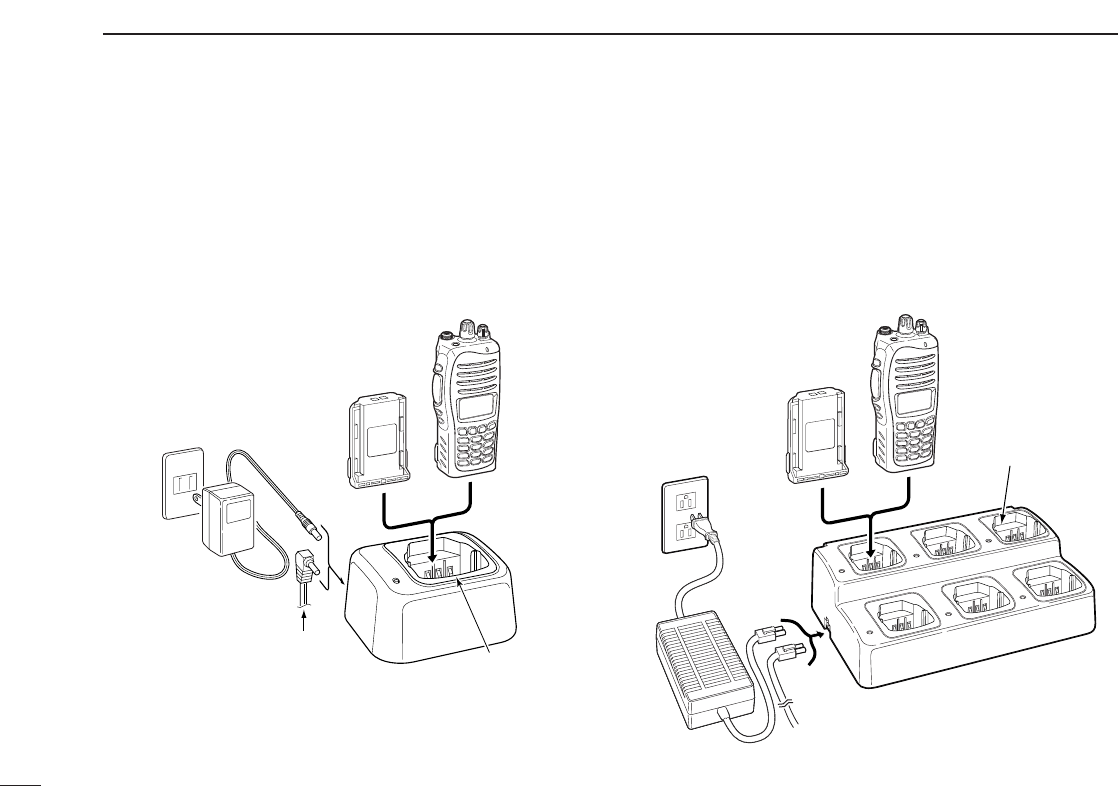
20
6BATTERY CHARGING
ïRapid charging with the BC-119N+AD-106
The optional BC-119N provides rapid charging of battery
packs. The following items are additionally required.
• AD-106 charger adapter
• An AC adapter (may be supplied with BC-119N depending
on version) or the DC power cable (OPC-515L/CP-17L).
ïRapid charging with the BC-121N+AD-106
The optional BC-121N allows up to 6 battery packs to be
charged simultaneously. The following items are additionally
required.
• Six AD-106 charger adapters
• An AC adapter (BC-124) or the DC power cable (OPC-656)
IC-F3061
BP-232
AD-106 charger
adapters are installed
in each slot.
DC power cable (OPC-656)
(Connect with the DC power supply;
13.8 V/at least 7 A)
AC adapter
(Purchased
separately)
AD-106 charger
adapter is installed
in BC-119N.
AC adapter
(Not supplied with
some versions.)
Optional OPC-515L (for 13.8 V
power source) or CP-17L (for 12
V cigarette lighter socket) can be
used instead of the AC adapter.
IC-F3061
BP-232
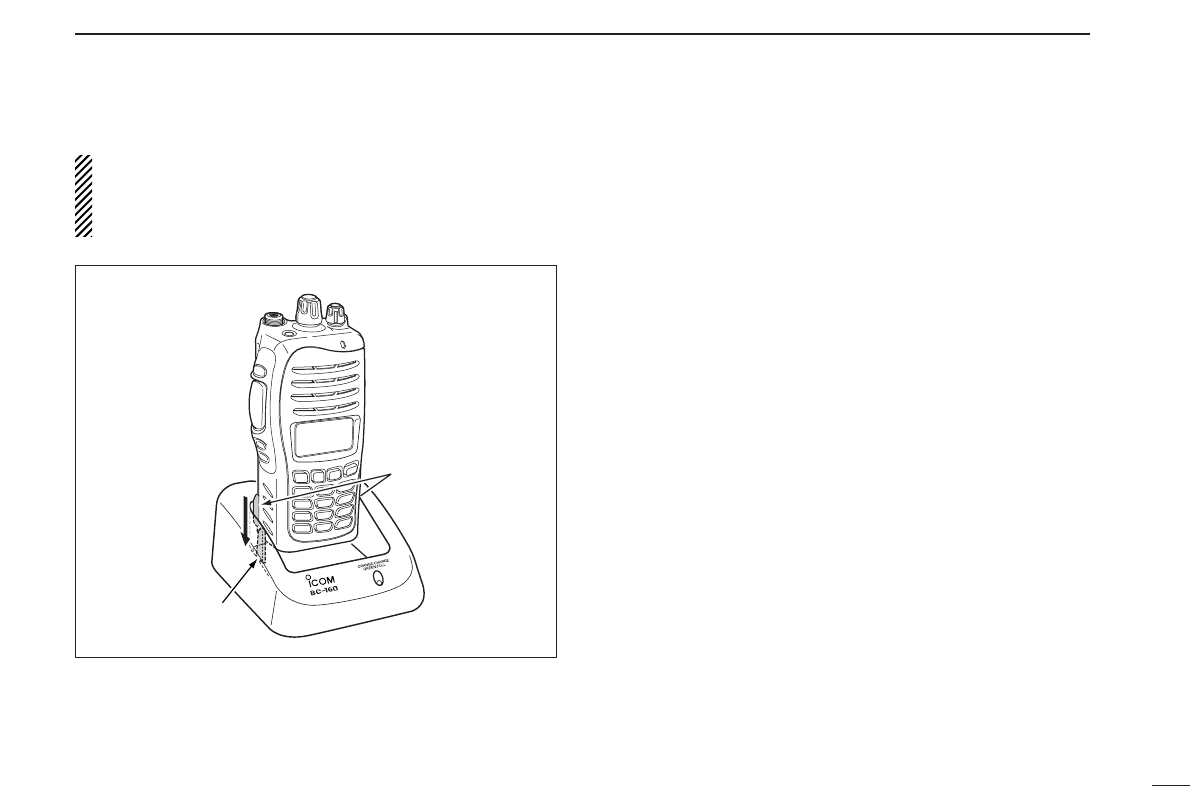
21
6
BATTERY CHARGING
IMPORTANT!: Battery charging
Ensure the guide lobs on the battery pack are correctly
aligned with the guide rails inside the charger adapter.
(This illustration is described with the BC-160.)
Guide rail
Lobs
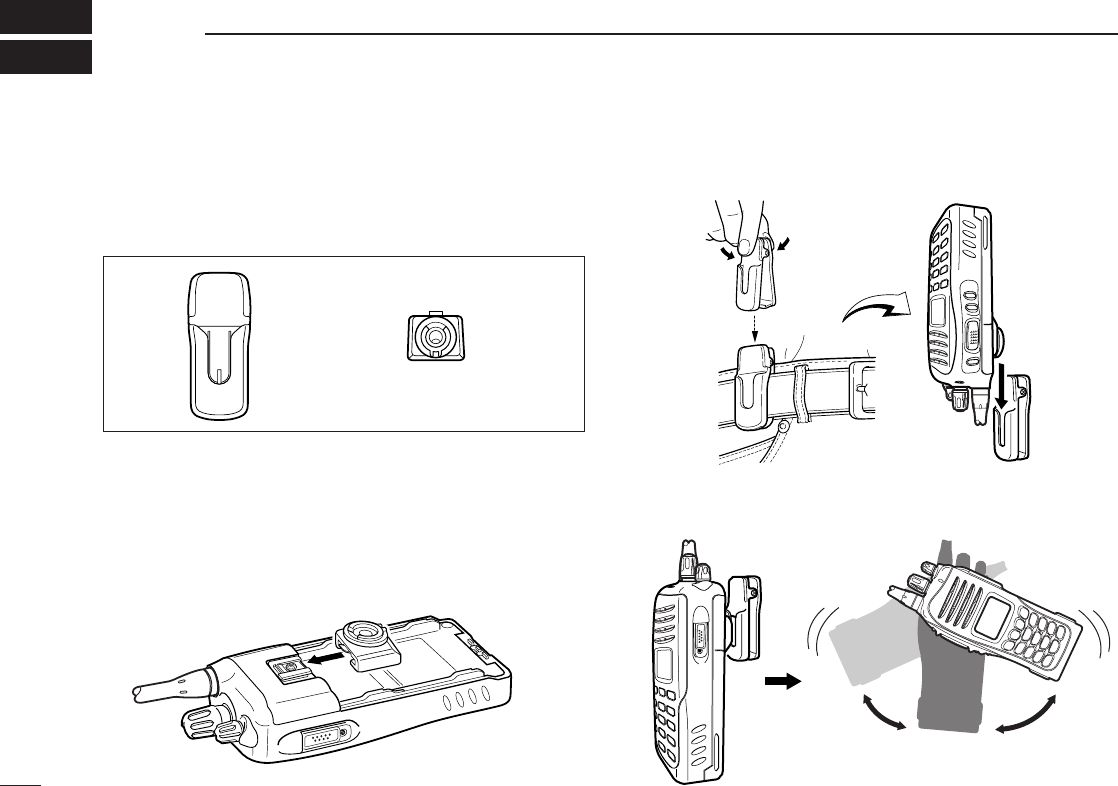
22
7SWIVEL BELT CLIP
■MB-93 contents
Qty.
qBelt clip ……………………………………………………… 1
wBase clip …………………………………………………… 1
■To attach
qRelease the battery pack if it is attached. (p. 2)
wSlide the base clip in the direction of the arrow until the
base clip is locked and makes a ‘click’ sound.
eClip the belt clip to a part of your belt. And insert the trans-
ceiver into the belt clip until the base clip inserted fully into
the groove.
rOnce the transceiver is locked in place, it swivels as illus-
trated below.
Once the transceiver is locked in place,
it will swivel 360 degrees.
q w
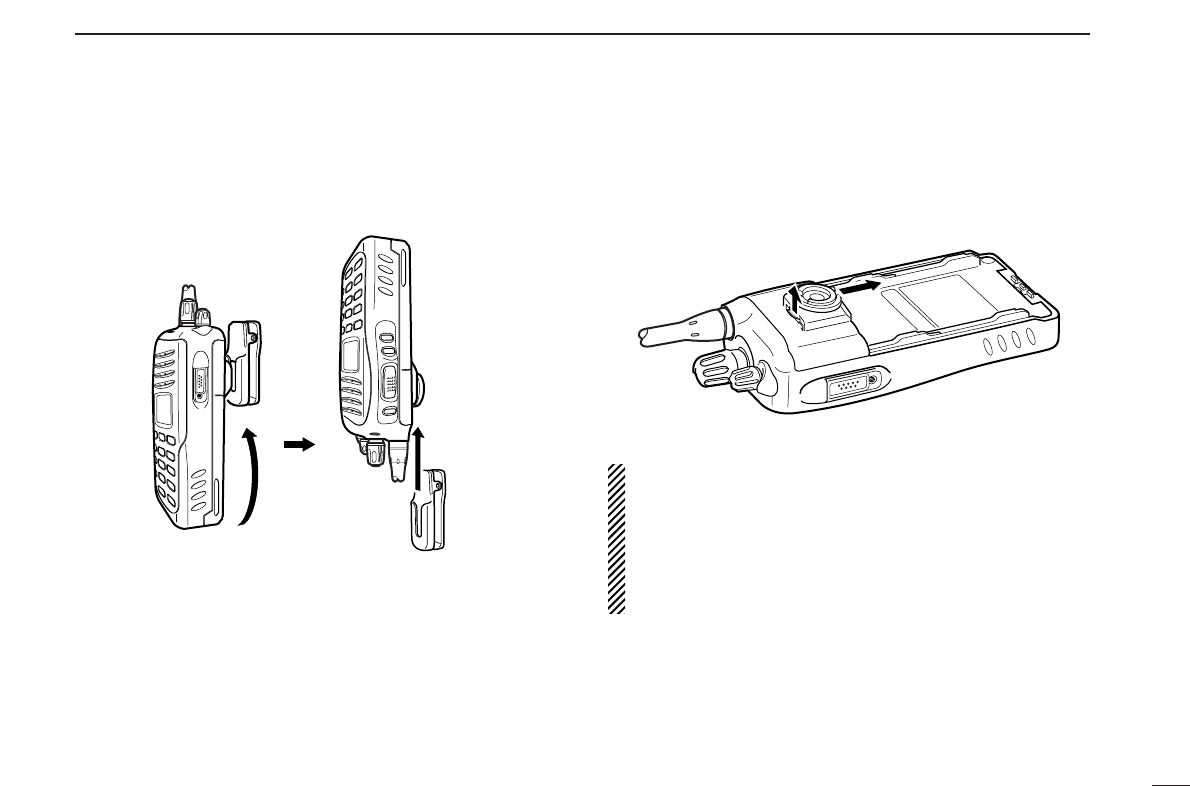
23
7
SWIVEL BELT CLIP
■To detach
qTurn the transceiver upside down in the direction of the
arrow and pull out from the belt clip.
wRelease the battery pack if it is attached. (p. 2)
ePinch the clip (q), and slide the base clip in the direction
of the arrow (w).
CAUTION!
HOLD THE TRANSCEIVER TIGHTLY, WHEN HANGING
OR DETACHING THE TRANSCEIVER FROM THE BELT
CLIP.
Otherwise the transceiver may not be attached to the hold-
er or swivel properly if the transceiver is accidentally
dropped and the base clip is scratched or damaged.
qw

24
8OPTIONS
DCHARGERS
•BC-119N
DESKTOP CHARGER
+ AD-106
CHARGER ADAPTER
+ BC-145
AC ADAPTER
For rapid charging of battery packs. An AC adapter is sup-
plied with the charger depending on versions. Charging
time: approx. 2 hours when BP-231 is attached.
•BC-121N
MULTI
-
CHARGER
+ AD-106
CHARGER ADAPTER
(6 pcs.)
+ BC-124
AC ADAPTER
For rapid charging of up to 6 battery packs (six AD-106’s are
required) simultaneously. An AC adapter should be pur-
chased separately. Charging time: approx. 2 hours when
BP-231 is attached.
•BC-160
DESKTOP CHARGER
+ BC-145
AC ADAPTER
For rapid charging of battery packs. An AC adapter is sup-
plied with the charger depending on versions. Charging
time: approx. 2 hours when BP-231 is attached.
DBELT CLIPS
•MB-93
SWIVEL BELT CLIP
•MB-94
BELT CLIP
Exclusive alligator-type belt clip. The same as supplied with
the transceiver.
•MB-96N/96F
LEATHER BELT HANGER
DOPTIONAL UNITS
•UT-119
DIGITAL MODULATOR
/
DEMODULATOR UNIT
Provides 6.25 kHz narrow bandwidth digital mode operation.
• UT-109R /UT-110R
SCRAMBLER UNITS
Non-rolling type (UT-109R)/Rolling type (UT-110R) voice
scrambler unit provides higher communication security.

25
8
OPTIONS
DDC CABLES
•CP-17L
CIGARETTE LIGHTER CABLE
Allows charging of the battery pack through a 12 V cigarette
lighter socket. (For BC-119N)
•OPC-515L/OPC-656
DC POWER CABLES
Allows charging of the battery pack using a 13.8 V power
source instead of the AC adapter.
OPC-515L: For BC-119N
OPC-656 : For BC-121N
DOTHER OPTIONS
•SP-13
EARPHONE
Provides clear receive audio in noisy environment.
•HM-131SC
SPEAKER
-
MICROPHONE
Combination speaker-microphone that provides convenient
operation while hanging the transceiver from your belt.
•HS-94/HS-95/HS-97
HEADSET
+ VS-1SC
VOX
/
PTT CASE
HS-94: Ear-hook type
HS-95: Neck-arm type
HS-97: Throat microphone
VS-1SC: VOX/PTT switch box for hands-free operation, etc.
Some options may not available in some countries. Please ask your
dealer for details.
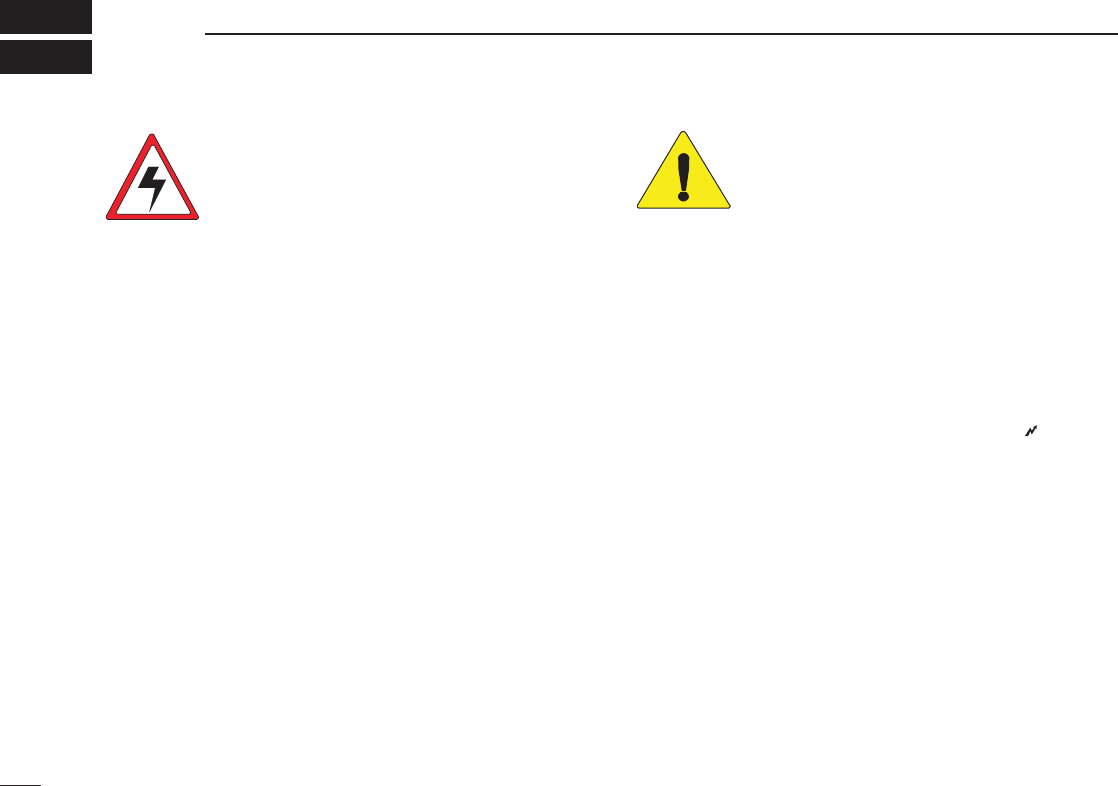
26
9SAFETY TRAINING INFORMATION
Your Icom radio generates RF electromagnetic
energy during transmit mode. This radio is
designed for and classified as “Occupational Use
Only”, meaning it must be used only during the
course of employment by individuals aware of the
hazards, and the ways to minimize such hazards.
This radio is NOT intended for use by the “General Population” in
an uncontrolled environment.
This radio has been tested and complies with the FCC RF expo-
sure limits for “Occupational Use Only”. In addition, your Icom
radio complies with the following Standards and Guidelines with
regard to RF energy and electromagnetic energy levels and eval-
uation of such levels for exposure to humans:
• FCC OET Bulletin 65 Edition 97-01 Supplement C,
Evaluating Compliance with FCC Guidelines for Human
Exposure to Radio Frequency Electromagnetic Fields.
• American National Standards Institute (C95.1-1992), IEEE
Standard for Safety Levels with Respect to Human Exposure
to Radio Frequency Electromagnetic Fields, 3 kHz to 300
GHz.
• American National Standards Institute (C95.3-1992), IEEE
Recommended Practice for the Measurement of Potentially
Hazardous Electromagnetic Fields– RF and Microwave.
• The following accessories are authorized for use with this
product. Use of accessories other than those specified may
result in RF exposure levels exceeding the FCC require-
ments for wireless RF exposure.; Belt Clip (MB-94),
Rechargeable Li-Ion Battery Pack (BP-231) and Speaker-
microphone (HM-131L).
To ensure that your expose to RF electromag-
netic energy is within the FCC allowable limits
for occupational use, always adhere to the fol-
lowing guidelines:
• DO NOT operate the radio without a proper antenna
attached, as this may damaged the radio and may also
cause you to exceed FCC RF exposure limits. A proper
antenna is the antenna supplied with this radio by the manu-
facturer or antenna specifically authorized by the manufac-
turer for use with this radio.
• DO NOT transmit for more than 50% of total radio use time
(“50% duty cycle”). Transmitting more than 50% of the time
can cause FCC RF exposure compliance requirements to be
exceeded. The radio is transmitting when the “ ” (TX indi-
cator) lights. You can cause the radio to transmit by pressing
the “PTT” switch.
• ALWAYS keep the antenna at least 2.5 cm (1 inch) away
from the body when transmitting and only use the Icom belt-
clips listed on page 40 when attaching the radio to your belt,
etc., to ensure FCC RF exposure compliance requirements
are not exceeded. To provide the recipients of your transmis-
sion the best sound quality, hold the antenna at least 5 cm
(2 inches) from your mouth, and slightly off to one side.
The information listed above provides the user with the informa-
tion needed to make him or her aware of RF exposure, and what
to do to assure that this radio operates with the FCC RF expo-
sure limits of this radio.
CAUTION
WARNING

27
9
SAFETY TRAINING INFORMATION
Electromagnetic Interference/Compatibility
During transmissions, your Icom radio generates RF energy that
can possibly cause interference with other devices or systems.
To avoid such interference, turn off the radio in areas where signs
are posted to do so. DO NOT operate the transmitter in areas
that are sensitive to electromagnetic radiation such as hospitals,
aircraft, and blasting sites.
Occupational/Controlled Use
The radio transmitter is used in situations in which persons are
exposed as consequence of their employment provided those
persons are fully aware of the potential for exposure and can
exercise control over their exposure.

1-1-32 Kamiminami, Hirano-ku, Osaka 547-0003, Japan
A-6488H-1EX
Printed in Japan
©2006 Icom Inc.